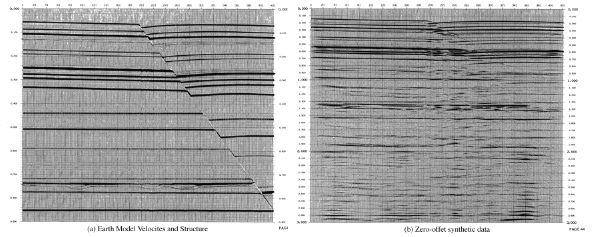Canadian Glauconitic Channel Play
Figure 1 shows a hard rock channel play velocity model together with a zero-offset exploding reflector simulation. Two channels are visible just below 700 meters. This model is based on glauconitic channel plays in Canada. The job is to image the channels just below 1300 milliseconds.
Figure 2 shows a pure phase-shift migration versus a two-way reverse time migration. Note that while the phase-shift was performed as a time migration, and the reverse time migration was actually a depth migration, a simple squeeze plot of the depth migration provides an excellent basis for direct comparison between the two images.
In Figure 3, the 45 degree migration was produced by an approximation to the one-way wave equation that was expected to image dips only up to approximately 45 degrees. Such migrations were the rule for many years and were considered to be the best possible migrations by many contractors. Clearly, the reverse-time migration on the right is superior to the 45 degree migration on the left. In this case, the improved accuracy of the reverse time method is preferable.
The FK or Stolt migration on the left of Figure 4 works well for this example. Velocity variations are not strong, so the constant velocity assumptions inherent in this approach are not a serious issue. Still, the reverse-time migration on the right is probably better.
Figure 5 shows that cascading migrations produce the best comparison between migration techniques. However, the reverse-time migration still has fewer artifacts and appears much clearer.





